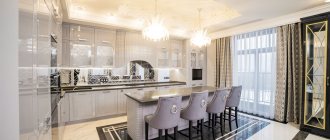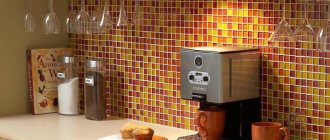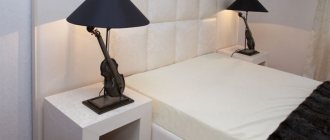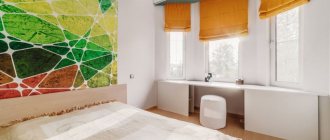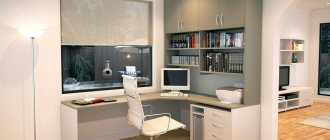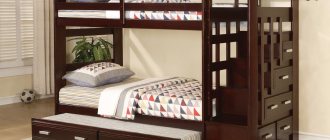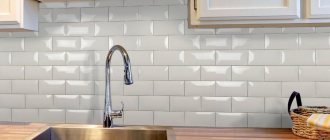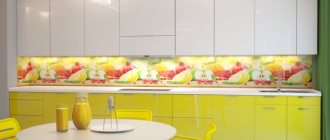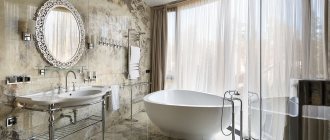The most popular option for finishing a kitchen backsplash in our country is ceramic tiles. It decorates the walls near the work area in 90% of kitchens. But tiles differ in variety; they have their own fashion trends and tendencies. This is exactly the trend that the “Boar” tile for the kitchen backsplash has become: it looks simple but very stylish. Such a decorative solution can fit into almost any interior by choosing tiles of different colors, designs and sizes. Now such cladding can be called not only a trendy option, but also a universal one.
Kabanchik is a rectangular tile that looks like a brick. Most often it has a glossy smooth surface and chamfers around the perimeter - sometimes they are also called bevel. This form of tile gives volume and texture to the lined surface. The most common color is white, but there are many varieties of boar.
Main dimensions of hog tiles
Kabanchik is a rectangular ceramic tile that resembles a brick.
Initially, it was used for cladding buildings, then it migrated to the walls of the subway, which is why in the USA and Great Britain it is called “subway”. The boar has three main sizes:
- small 7.5x10 cm;
- large 10x20 (10x30) cm;
- large 28.5x8.5 cm.
Since large tiles visually make small-sized kitchens smaller, a standard size of 10x20 cm is used for them. Any product is suitable for spacious rooms.
Why is it called that?
The question “What is this?” often occurs to people when a designer starts talking about a pig in the kitchen.
This tile is called this way only in Russian-speaking countries. This is due to the tile manufacturing process: its blank at the end has two holes that resemble the heels of a pig. The nickname passed from production to the people, and it stuck.
In the West, this tile is called “Metro”. As the name suggests, it is installed in the subway and other public places because it looks simple and neat. Initially, buildings were lined with boar, then metro crossings. Unfortunately, information about who began to use it to decorate the house has not been preserved.
Types of hog tiles
A distinctive feature of the hog is the chamfers - beveled edges running along the perimeter.
With chamfer
Chamfers (or facets) add volume to the product. The glazed surface looks especially impressive with them.
The photo shows a kitchen in chocolate shades, tiled with convex tiles with bevels.
Without chamfer
Flat products without a chamfer look laconic and are used if you do not want to overload the space with relief textures.
Tile backsplash color
Since the demand for boar is great, manufacturers are producing more and more new types of tiles, using the entire color palette, and also playing with textures, imitating natural materials.
White
This color remains popular due to its versatility. Ideally harmonizes with any shade, does not attract special attention, adding “air”.
The photo shows a kitchen with a white apron, originally located on the lower part of the wall.
Black
A deep black splashback is a bold and incredibly stylish way to highlight your workspace. The dark hog looks luxurious, but has a small drawback: any dirt is clearly visible on its glossy surface.
The photo shows a youth kitchen in which not only the apron is decorated with hog, but also the wall above the doorway.
Blue
Sky or dark blue tiles look original and add freshness to the interior.
Beige
An apron of a neutral shade fits well into a kitchen of pastel (milky, blue) tones. Sometimes it serves as a backdrop for bright furnishings.
Grey
Another universal apron color that is suitable for both light and dark kitchen facades.
Color
Color gives a kitchen its own character. A multi-colored apron will create a unique interior. And red will attract attention and create an atmosphere of hospitality.
Orange
If the kitchen lacks light and comfort, using an orange apron would be a great solution.
Yellow
The sunny yellow color of the apron adds cheerfulness to the interior or serves as a bright accent.
Green
Olive, pistachio, mint, light green – shades of green in the kitchen interior give a feeling of calm and natural harmony, and improve your mood.
The photo shows a kitchen with natural motifs. An olive splashback with a border harmonizes with the natural textures of the countertops and cabinets: marble and wood.
Lilac
This shade is rarely used for hog tiles. The lilac color gives the kitchen not only tenderness, but also uniqueness.
Tile care
Hog tiles are one of the most practical finishing materials, as the coating protects against any contamination and is easy to clean. The light colors of the apron create a neat look for the kitchen, and any stains, dust, or dirt are least noticeable on it. Care in such a situation is sometimes minimal - wiping with a damp cloth.
But dark and colored tiles will require more frequent maintenance, since any dirt on its surface is more noticeable.
Thanks to the wide variety of proposed layout options and color schemes for hog tiles, the most original and practical design of a modern kitchen is possible. Having created a unique design that meets the most demanding needs, you can cook dinners and spend your leisure time with pleasure.
Apron design
A kitchen apron, lined with a hog pattern, can stretch along a corner or occupy the entire wall. Depending on the area allocated for it, various types of coatings and additional decor are selected.
If the set occupies the entire wall, it is recommended to use glazed products. The glossy finish effectively reflects light, visually expanding the space.
Hog with a matte finish is less common. It is used in interiors where gloss is stylistically inappropriate, or in kitchens with an abundance of shiny surfaces.
The photo shows a black kitchen, the glossy apron of which is favorably illuminated by built-in lamps.
The hog can easily be combined with other tiles, for example, when you need to highlight the area between the stove and the hood. The mosaic, inscribed in the apron with a thin strip, looks harmonious.
The photo shows a small kitchen, decorated with an emerald-colored apron and patterned tiles in the stove area.
You can also combine different colors and layout methods.
Photo of tiles with a pattern
There are products, like regular tiles, that imitate natural textures: marble, brick.
A boar with an ornament, pattern or inscriptions is often found in the Scandinavian or Provence style.
Which grout should I choose for backsplash tiles?
First of all, it is worth considering its composition: grout based on epoxy resins, which is resistant to dirt, is best suited for the kitchen. If we talk about the palette, then for a plain neutral backsplash it is recommended to choose a grout that is similar in color to the tile itself. White and gray grout are considered universal.
The photo shows a burgundy-colored apron with matching grout, which “dissolves” the seams without focusing attention on them.
If you need to make an accent apron, you can use contrasting combinations. For example, black grout on white tiles will add a graphic touch to the interior. If the tiles are dark, white joints will highlight the texture or interesting shade.
The photo shows an example of contrasting grout. Without it, the wall above the work area would look empty and unfinished.
Recommendations
- To create a neutral backsplash, choose grout that matches the ceramic. To focus on the apron area, combine contrasting colors;
- Buy grout that is resistant to indoor moisture (the composition must contain epoxy resin). This composition is capable of maintaining color for a long time, so the high price of high-quality grout is fully justified. The shade of economical analogues quickly becomes dull;
- When purchasing material, you should include a reserve (about 8-10%). During the laying process, the tiles may be damaged, some of them will be used for trimming. Also, if you have a stock from one batch, you will be able to replace damaged elements, avoiding discrepancies;
- Entrust the work to an experienced craftsman, since the “hog” requires perfectly even seams. Especially if you choose a non-standard cladding option;
- On the eve of installation, you should carefully prepare the surface: prime and level the walls with putty, using a building level for guidance and adjustment of the work. Only perfectly smooth walls can be covered.
- The “hog” tile is heavier and thicker than the standard one, so it is better to purchase glue with a reserve. Remember this feature when controlling the process, since glue must be applied not only to the surface of the tile, but also to the wall (for good adhesion of the material and the base);
- The maximum thickness of the tile joint is 50 mm. Professional finishers form thin and even seams;
- To accurately join the corner elements, the tiles should be cut at 45 degrees. Mask the joint using ceramic corners (plastic ones look cheap);
- Accurate joining of the corners will be achieved by choosing a “hog” with a chamfer - in this case, you will not have to additionally file down the ceramics. The main thing is that the factory edge is directed towards the corner (you need to carefully monitor this).
Photo: remont-volot.ru, happymodern.ru, keramaexpo.by, picshare.ru, st.hzcdn.com, stekloholst.com, feedinspiration.com
Boar tile layout options
If you use plastic panels that imitate a hog, there will be only two cladding options: vertical and horizontal. But the rectangular shape of the individual tile elements allows you to lay it in several ways:
- Vertical with offset. A method by which you can visually lengthen a tiled wall.
- Horizontal staggering. The most common option is when the tiles are laid offset, like a brick.
- Horizontal stackable. A neat seam-to-seam method with an emphasis on geometric accuracy.
- Vertical stackable. A method designed to emphasize the severity of lines in the interior.
- Diagonally. The elements are placed at an angle of 45°. This option is suitable for small kitchens, as it visually expands the apron area.
- Herringbone. The tiles are laid in a zigzag pattern to create a beautiful pattern.
The photo shows a black vertical hog, adding respectability to the interior.
Difficulties in laying material
Nuances that need to be taken into account when a “hog” kitchen apron is installed by non-professionals:
- The need for trimming and adjustment in hard-to-reach places near pipes, columns, corners of the room, etc. Some of the tiles are cut at an angle of 45 degrees, the edge of the factory processing rests against the corner of the room, and the trimmed edge is masked with grout.
- The presence of a chamfer makes cutting difficult. There are options for additional purchase of shortened tiles and PVC corners to avoid cutting.
- The thinner the seam, the more complex the masonry. The seams should be as narrow and even as possible. The optimal seam thickness is 2-5 mm.
- Preliminary markings will make it possible to clearly observe verticals and horizontals.
Heavy tiles of a convex format are more difficult to fix on the wall. To increase adhesion, the wall must be carefully prepared.
How does a boar apron look in different interior styles?
Hog tiles are so multifunctional that they will fit into any interior.
Provence (“French country”) combines rustic simplicity and sophistication. The apron can have a pattern or, conversely, act as a backdrop for cozy little things and an antique set.
White tiles will fit into a spacious loft with rough textures, which will serve as a contrast to industrial furniture. An interesting option is when the smooth glossy coating of the apron echoes the textured brickwork.
Due to its laconic shape, the boar will harmoniously fit into both modern and Scandinavian kitchen styles.
The photo shows a kitchen in a modern direction with herringbone tiles.
In the classic style, a beige hog will find its application, highlighting the splendor of a luxurious set and rich decorative elements.
